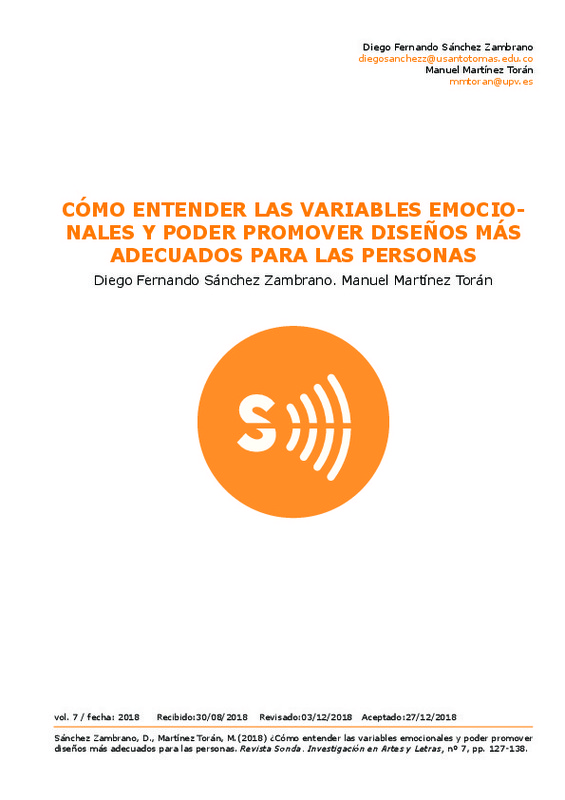BRAIDOT, N. (2013). Neuromarketing en acción, ¿por qué los clientes te engañana con otros si dicen que gustan de ti? (1a ed.). Buenos Aires: Ediciones Granica S.A.
Desmet, P. (2002). Designing emotions Delft University of Technology, Department of Industrial Design.
DESMET, P. M., & HEKKERT, P. (2002). The basis of product emotions. Pleasure with Products, Beyond Usability, , 60-68.
[+]
BRAIDOT, N. (2013). Neuromarketing en acción, ¿por qué los clientes te engañana con otros si dicen que gustan de ti? (1a ed.). Buenos Aires: Ediciones Granica S.A.
Desmet, P. (2002). Designing emotions Delft University of Technology, Department of Industrial Design.
DESMET, P. M., & HEKKERT, P. (2002). The basis of product emotions. Pleasure with Products, Beyond Usability, , 60-68.
DESMET, P., Overbeeke, K., & Tax, S. (2001). Designing products with added emotional value: Development and appllcation of an approach for research through design. The Design Journal, 4(1), 32-47..https://doi.org/10.2752/146069201789378496
DONALD A. Norman. (2011). La psicología de los objetos cotidianos Retrieved from http://data.theeuropeanlibrary.org/BibliographicResource/3000146817490
DREYFUSS, H. (2003). Designing for people Allworth Press. Retrieved from https://books.google.es/books?id=qOsJl7hW2qUC
EBERLE, B. (2008). Scamper: Creative games and activities for imagination development Prufrock Press.
HSU, S. H., Chuang, M. C., & Chang, C. C. (2000). A semantic differential study of designers' and users' product form perception https://doi.org/10.1016/S0169-8141(99)00026-8
JORDAN, P. W. (2003). Designing pleasurable products: An introduction to the new human factors CRC Press. Retrieved from https://books.google.com.co/books?id=aRDhd_Y9mOcC
JORDAN, P. W. (1998). Human factors for pleasure in product use. https://doi.org/10.1016/S0003-6870(97)00022-7
KAMIL, M. J. M., & Abidin, S. Z. (2013). Unconscious human behavior at visceral level of emotional design. https://doi.org/10.1016/j.sbspro.2013.11.016
LEWIS, C. S., & Urbina, P. A. (1991). Los cuatro amores Rialp. Retrieved from https://books.google.com.co/books?id=x9FxYgCLytQC
MANZANO DÍAZ, R., Gavilán, D., Avello, M., Abril, C., & Serra, T. (2012). Marketing sensorial. Madrid: Pearson Educación.
NAGAMACHI, M. (1995). Kansei engineering: A new ergonomic consumer-oriented technology for product development https://doi.org/10.1016/0169-8141(95)90025-X
NORMAN, D. A., & VERGANTI, R. (2014). Incremental and radical innovation: Design research vs. technology and meaning change. Design Issues, 30(1), 78-96. https://doi.org/10.1162/DESI_a_00250
NORMAN, D. (2007). Emotional design : Why we love (or hate) everyday things (1st ed.). New York: Basic Books. Retrieved from https://ebookcentral.proquest.com/lib/[SITE_ID]/detail.action?docID=876410
PHILIP, K., & ARMSTRONG, G. (2012). Marketing Retrieved from file:///C:/Users/Sony/BoxSync/Libros/marketing-140810121846-phpa-pp02.pdf
ROBBINS, S., & COULTER MARY. (2010). Administración (Décima ed.) Pearson Educación.
SCHIFFERSTEIN, H. N. J., & DESMET, P. M. A. (2010). Hedonic asymmetry in emotional responses to consumer products. https://doi.org/10.1016/j.foodqual.2010.07.004
SCHÜTTE, S. (2002). Designing feelings into products : Integrating kansei engineering methodology in product development Retrieved from http://urn.kb.se/resolve?urn=urn:nbn:se:liu:diva-2658
SHAHIN, A., JAVADI, M. H. M., & SHAHRESTANI, H. V. (2014). Integrating kansei engineering and revised kano model with a case study in the automobile industry. International Journal of Productivity and Quality Management, 13(2), 201-218. Stanton, W., Etzel, M., & Walker, B. (2007). Fundamentos de marketing (14th ed.). México: McGraw-Hill. https://doi.org/10.1504/IJPQM.2014.059176
TORRENT, R., & MARÍN, J. M. (2005). Historia del diseño industrial. Madrid: Ed. Cátedra.
[-]









